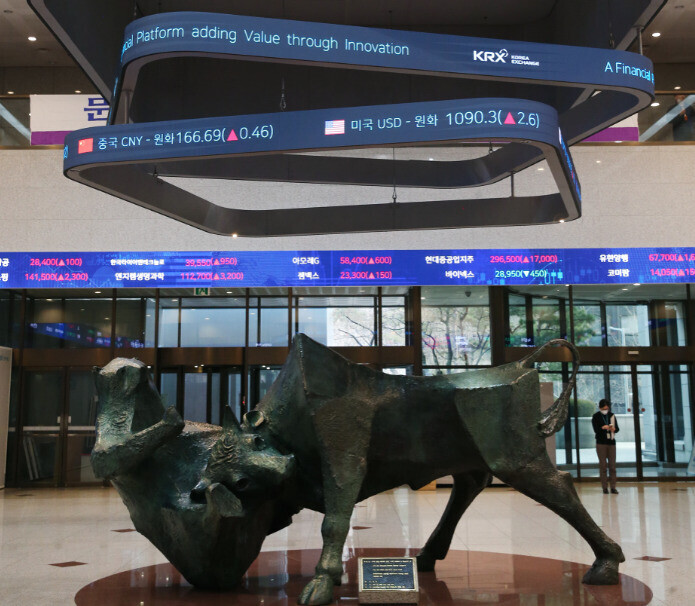hankyoreh
Links to other country sites 다른 나라 사이트 링크
Investment loan increase rate in S. Korea three times higher than in US, five times Japan

The rise in investment loans in South Korea has been three times higher than in the US and five times higher than in Japan after the COVID-19 pandemic led to steep declines in stock prices last year, analysis findings on Monday showed.
Investment loans are loans in which individual investors borrow funds from securities companies to purchase stocks.
A capital market risk analysis report recently published by the Financial Supervisory Service (FSS) showed a collective credit loan balance of 19.2 trillion won (US$17 billion) as of late 2020.
The total was up by fully 155.6% from the 7.5 trillion won (US$6.67 billion) recorded in March of the same year. This means that individual investors incurred major debt to invest in stocks last year when prices were fluctuating sharply due to the pandemic’s effects.
The increase rate was roughly three times and 5.2 times higher than the respective rates in the US and Japan.
In the US, the credit loan balance rose by 51% from US$470 billion to US$720 billion between March and the end of 2020. In Japan, it rose by 30% from 1.84 trillion yen (US$16.6 billion) to 2.4 trillion yen (US$21.7 billion) over the same period.
Investment loans rose across all age groups last year, with a particularly sharp rise among younger people. Among people aged under 30, the balance of investment loans totaled 480 billion won (US$427 million) as of the end of 2020, representing a rise of 320 billion won (US$284 million) compared with 160 billion won (US$142 million) as of late 2019.
In terms of sheer financial value, the amount was not especially large, but the increase rate was a full 200%.
Investment loans are a typical example of leveraged investment, using funds borrowed at high interest rates from security companies. For the most part, they are used for short-term investments lasting between several days and weeks.
This approach to investing can produce a leverage effect when the target stock prices rise, but it can also result in heavy losses as the prices become adjusted.
In cases where stock prices plummet particularly sharply, it can cause snowballing losses due to covering by securities companies, leaving investors without the opportunity to sell off at a loss at a suitable moment. Covering refers to a securities company forcibly selling off shares to recoup a loan when investors are unable to pay their transaction fees by the designated date.
As of late 2019, 26.9% of accounts showed a strong likelihood of being subject to covering — representing over one out of every four credit accounts. In general, securities companies proceed with covering once the assessment value of the investor’s stocks falls below 140% of their credit exposure balance. At that time, the company sells off a portion corresponding to the security shortfall.
“Stock prices have recovered rapidly and broken outside their previous box as individual investors have emerged as a driving force on the domestic market amid the COVID-19 crisis,” the FSS explained.
“We’re facing new challenges with the emergence of risk factors such as increased leveraged investment. With the investment loan balance issue in particular, the rate of increase has been higher than in other countries such as the US or Japan, which translates into a growing risk in terms of credit transactions,” it added.
The FSS also noted that as more and more individuals invest in stocks directly, they risk falling prey to harmful business activities by “stock leading rooms” — anonymous investment tipsters operating through group chats — and remote marketing through securities companies’ YouTube channels.
By Park Hyun, senior staff writer
Please direct comments or questions to [english@hani.co.kr]

Editorial・opinion
![[Column] Season 2 of special prosecutor probe may be coming to Korea soon [Column] Season 2 of special prosecutor probe may be coming to Korea soon](https://flexible.img.hani.co.kr/flexible/normal/500/300/imgdb/original/2024/0426/3317141030699447.jpg) [Column] Season 2 of special prosecutor probe may be coming to Korea soon
[Column] Season 2 of special prosecutor probe may be coming to Korea soon![[Column] Park Geun-hye déjà vu in Yoon Suk-yeol [Column] Park Geun-hye déjà vu in Yoon Suk-yeol](https://flexible.img.hani.co.kr/flexible/normal/500/300/imgdb/original/2024/0424/651713945113788.jpg) [Column] Park Geun-hye déjà vu in Yoon Suk-yeol
[Column] Park Geun-hye déjà vu in Yoon Suk-yeol- [Editorial] New weight of N. Korea’s nuclear threats makes dialogue all the more urgent
- [Guest essay] The real reason Korea’s new right wants to dub Rhee a founding father
- [Column] ‘Choson’: Is it time we start referring to N. Korea in its own terms?
- [Editorial] Japan’s rewriting of history with Korea has gone too far
- [Column] The president’s questionable capacity for dialogue
- [Column] Are chaebol firms just pizza pies for families to divvy up as they please?
- [Column] Has Korea, too, crossed the Rubicon on China?
- [Correspondent’s column] In Japan’s alliance with US, echoes of its past alliances with UK
Most viewed articles
- 1‘We must say no’: Seoul defense chief on Korean, USFK involvement in hypothetical Taiwan crisis
- 2[Column] Season 2 of special prosecutor probe may be coming to Korea soon
- 3N. Korean delegation’s trip to Iran shows how Pyongyang is leveraging ties with Moscow
- 4Amnesty notes ‘erosion’ of freedom of expression in Korea in annual human rights report
- 5Korea sees more deaths than births for 52nd consecutive month in February
- 6[Reportage] On US campuses, student risk arrest as they call for divestment from Israel
- 7[Editorial] New weight of N. Korea’s nuclear threats makes dialogue all the more urgent
- 8‘Weddingflation’ breaks the bank for Korean couples-to-be
- 9Division commander ordered troops to enter raging flood waters before Marine died, survivor says
- 10[Editorial] Korea’s surprise Q1 growth requires objective assessment, not blind fanfare